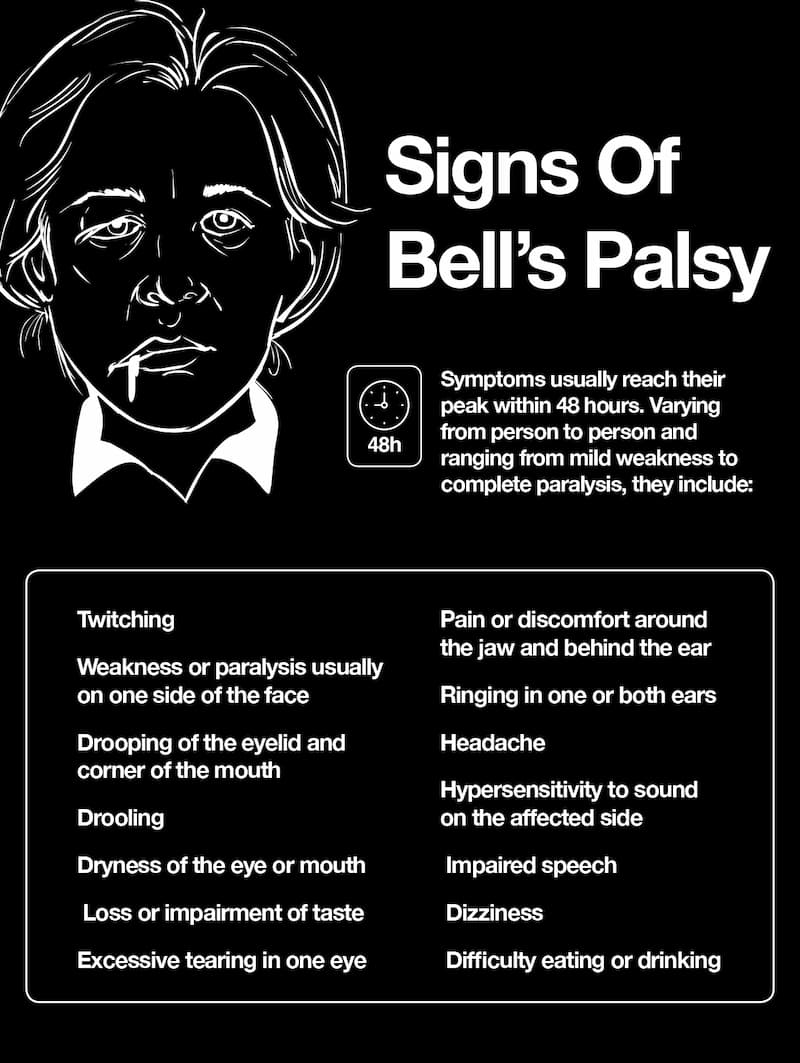
Bell's palsy, also known as acute peripheral facial palsy, is a medical condition that affects the facial muscles and can lead to facial paralysis if not treated properly. It was named after Charles Bell, a Scottish anatomist who was the first to describe facial nerve paralysis. While some people with the condition may reach complete recovery after treatment, others suffer from long-term facial weakness, if not permanent paralysis. Learn about the main cause and common symptoms of facial nerve palsy, as well as how it is diagnosed and how you can assist someone who is suffering from it.
What are the Causes of Bell's Palsy?
Damage or trauma to one of the cranial nerves that stem from the brain, particularly the seventh cranial nerve, which controls the facial muscles on one side of the face, is believed to cause Bell's palsy. How this happens remains unknown, but it may be due to a viral infection, head injury or stroke. Other risk factors for developing Bell's palsy include pregnancy, diabetes, and HIV or AIDS.
There are a few factors that can increase the risk for Bell's palsy, including:
- Older age
- Diabetes mellitus
- Herpes simplex virus or hepatitis B
- Autoimmune diseases, such as lupus erythematosus or rheumatoid arthritis
- Trauma to the head or face
Although Bell's palsy is not considered a life-threatening condition, it can still cause some significant problems. The most common complication of Bell's palsy is permanent facial weakness or paralysis. This occurs in about one-third of people who have the condition. Other potential complications include:
- Vision problems such as dry eyes, double vision and eyelid drooping
- Problems with the auditory canals that may lead to hearing loss and tinnitus
- Difficulty speaking or swallowing
- Facial pain and stiffness
- Psychiatric problems such as depression and anxiety
What are Warning Signs of Bell's Palsy?
Bell's palsy symptoms vary from person to person, and their severity is determined by the extent of facial nerve function damage. The following are typical Bell's palsy symptoms:
- Facial muscle weakness on one side of the face that lasts for a few hours to days
- Loss of taste or abnormal taste sensations
- Jaw or ear pain
- Difficulty closing eyes
- Sagging face
- Drooling
- Excess tear production
Some people may exhibit additional symptoms, such as intolerance to loud noises, headaches and facial nerve paralysis on both sides of the face.
Source: The Amino Co
How is Bell's Palsy Diagnosed?
Unfortunately, there is no specific test for diagnosing Bell's palsy. If you suspect you have Bell's palsy, your healthcare professional will perform a physical exam and review your medical history to rule out other health conditions whose symptoms are similar to those of Bell's palsy, such as stroke or bacterial infections. Aside from assessing your facial movements, your healthcare provider may use the following diagnostic procedures:
- Electromyography (EMG)
- Magnetic resonance imaging (MRI)
- Computed tomography (CT) scan
- Blood tests
If you experience facial muscle paralysis along with any of the above-mentioned symptoms within three days of the onset of symptoms, you must seek medical attention immediately.
What are the Treatment Options for Bell's Palsy?
Early treatment can often prevent further damage and improve the chances of a full recovery. Although there is no known cure for Bell's palsy, your healthcare provider may recommend antiviral medications or over-the-counter pain relievers such as oral corticosteroids to help with facial nerve swell. Eye care is also very important, and your doctor may prescribe lubricating eye drops to keep your eyes moist and to relieve pain when opening and closing them. However, be wary of long-term medication use, as it may result in a slew of side effects, including:
- Fluid retention or oedema
- High blood pressure
- Stomach pain
- Dizziness or lightheadedness
- Memory problems
- Irregular heartbeat
- Respiratory infections
- Aggression
- Confusion
It's a good thing that there are natural therapies that can help in the management of Bell's palsy, thus reducing your reliance on conventional drugs and your chances of suffering their adverse effects. Here are some treatment options you can discuss with your doctor to help you cope with the symptoms of Bell's palsy:
Physical Therapy
Physical therapy can help to improve the facial muscles and reduce the likelihood of potential facial distortion resulting from Bell's palsy. It may also help to improve the person's swallowing and chewing abilities. In some cases, physical therapy may also help to improve speech problems caused by Bell's palsy.
Acupuncture
There is some evidence that acupuncture can help with the treatment of Bell's palsy. A study published in the journal BMC Complementary and Alternative Medicine in 2016 found that acupuncture was more effective than usual care in improving the symptoms of Bell's palsy. The study participants were randomly assigned to receive either eight sessions of acupuncture or usual care, which consisted of steroids, antiviral medications and physical therapy. At the end of the study, those who received acupuncture had a significantly better outcome in terms of facial symmetry and muscle strength. Additionally, they reported less pain and an improved quality of life. While more research is needed on this topic, these results suggest that acupuncture may be a helpful treatment for Bell's palsy.
Biofeedback
This therapeutic technique can help people with Bell's palsy improve their muscle function and facial nerve function. It does this by teaching people how to control their involuntary body functions, such as heart rate, blood pressure, skin temperature and muscle tension. This can help to reduce some of the symptoms of Bell's palsy, such as facial muscle spasms and pain. Biofeedback may also help to improve facial nerve function and reduce the risk of complications.
If you are experiencing any of the symptoms of Bell's palsy, it is important to see a doctor for evaluation and treatment. If you are considering using natural therapy to help with your condition, be sure to discuss it with your healthcare provider first to ensure the best possible outcome.










